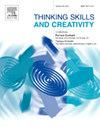A qualitative metasynthesis: Interaction between mathematical modeling and higher order thinking
IF 4.5
2区 教育学
Q1 Social Sciences
引用次数: 0
Abstract
In the current educational context, there is an increasing emphasis on developing students' higher-order thinking skills, along with a search for methods that effectively enhance these abilities. Mathematical modeling, with its problem structure that promotes complex and non-algorithmic thinking, is regarded as an approach that can create optimal conditions for fostering higher-order thinking skills. The existing literature provides valuable insights for practitioners on how to cultivate these skills in mathematics instruction while also guiding researchers in deepening their exploration of these constructs. In response to this need, we conducted a meta-synthesis study to thoroughly examine research focused on the relationship between mathematical modeling and higher-order thinking. Our objective was to explore both how higher-order thinking is reflected in the mathematical modeling process and how mathematical modeling contributes to the development of higher-order thinking skills. We synthesized 12 articles that met the quality criteria through an open-coding and categorization process. Our findings revealed a bidirectional relationship between mathematical modeling and higher-order thinking. Additionally, we identified several key factors that should be considered before, during, and after implementation to maximize the interaction between higher-order thinking and the mathematical modeling process. These factors include the context and structure of the mathematical modeling task, teacher actions during the modeling process, students' experiences, instructional elements, and the nature of the stages in the modeling process. The synthesized results offer valuable insights for practitioners seeking to improve classroom instruction and for researchers aiming to identify gaps in the field.
定性综合:数学建模与高阶思维的互动
在当前的教育背景下,人们越来越强调培养学生的高阶思维技能,同时寻找有效提高这些能力的方法。数学建模的问题结构促进了复杂和非算法思维,被认为是一种可以为培养高阶思维技能创造最佳条件的方法。现有文献为实践者提供了如何在数学教学中培养这些技能的宝贵见解,同时也指导了研究人员深化对这些结构的探索。为了响应这一需求,我们进行了一项综合研究,以彻底检查专注于数学建模与高阶思维之间关系的研究。我们的目标是探索高阶思维如何反映在数学建模过程中,以及数学建模如何促进高阶思维技能的发展。我们通过开放编码和分类过程合成了12篇符合质量标准的文章。我们的发现揭示了数学建模和高阶思维之间的双向关系。此外,我们确定了在实现之前、期间和之后应该考虑的几个关键因素,以最大限度地提高高阶思维和数学建模过程之间的相互作用。这些因素包括数学建模任务的背景和结构、教师在建模过程中的行为、学生的经验、教学要素以及建模过程中各个阶段的性质。综合结果为寻求改善课堂教学的从业者和旨在确定该领域差距的研究人员提供了有价值的见解。
本文章由计算机程序翻译,如有差异,请以英文原文为准。
求助全文
约1分钟内获得全文
求助全文
来源期刊

Thinking Skills and Creativity
EDUCATION & EDUCATIONAL RESEARCH-
CiteScore
6.40
自引率
16.20%
发文量
172
审稿时长
76 days
期刊介绍:
Thinking Skills and Creativity is a new journal providing a peer-reviewed forum for communication and debate for the community of researchers interested in teaching for thinking and creativity. Papers may represent a variety of theoretical perspectives and methodological approaches and may relate to any age level in a diversity of settings: formal and informal, education and work-based.
 求助内容:
求助内容: 应助结果提醒方式:
应助结果提醒方式:


